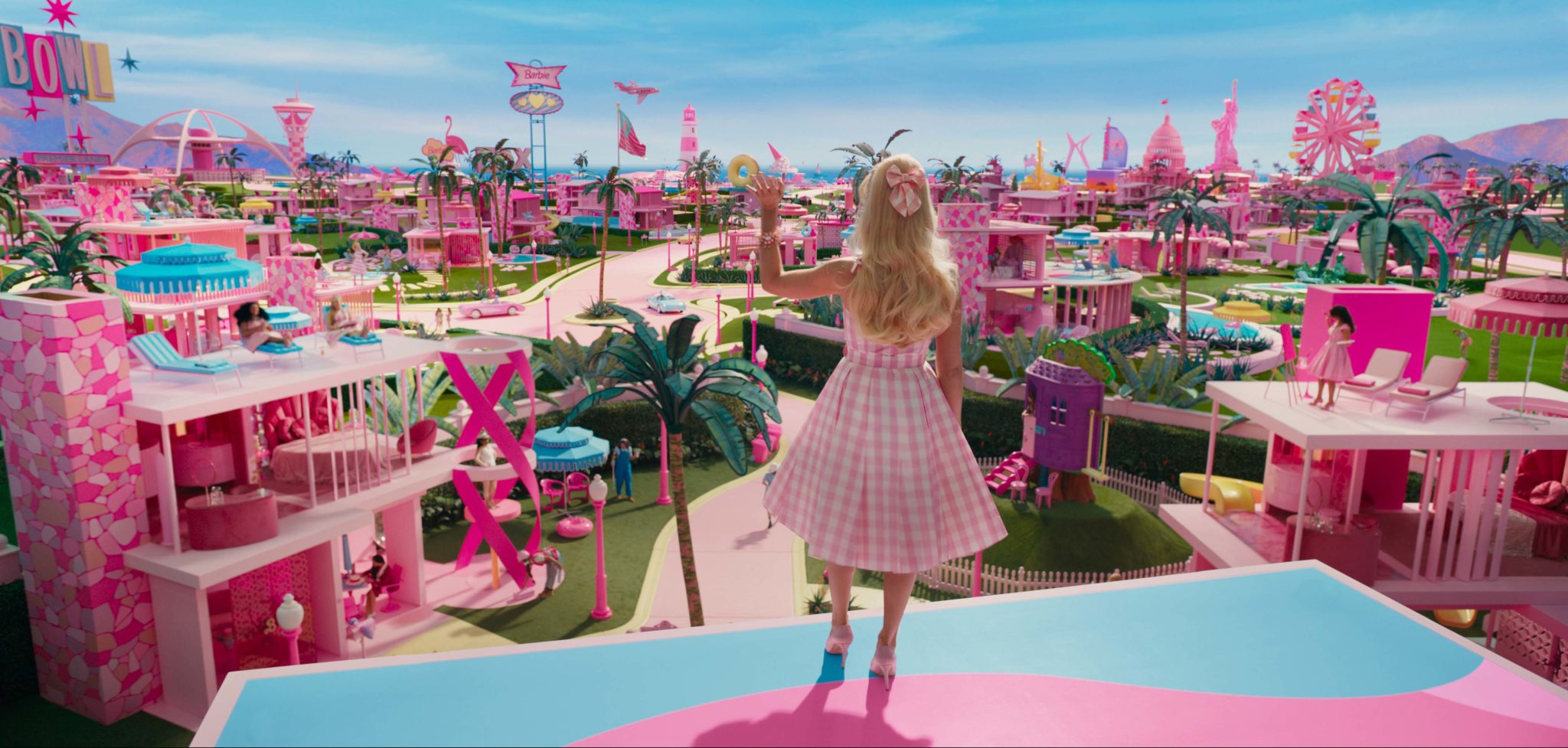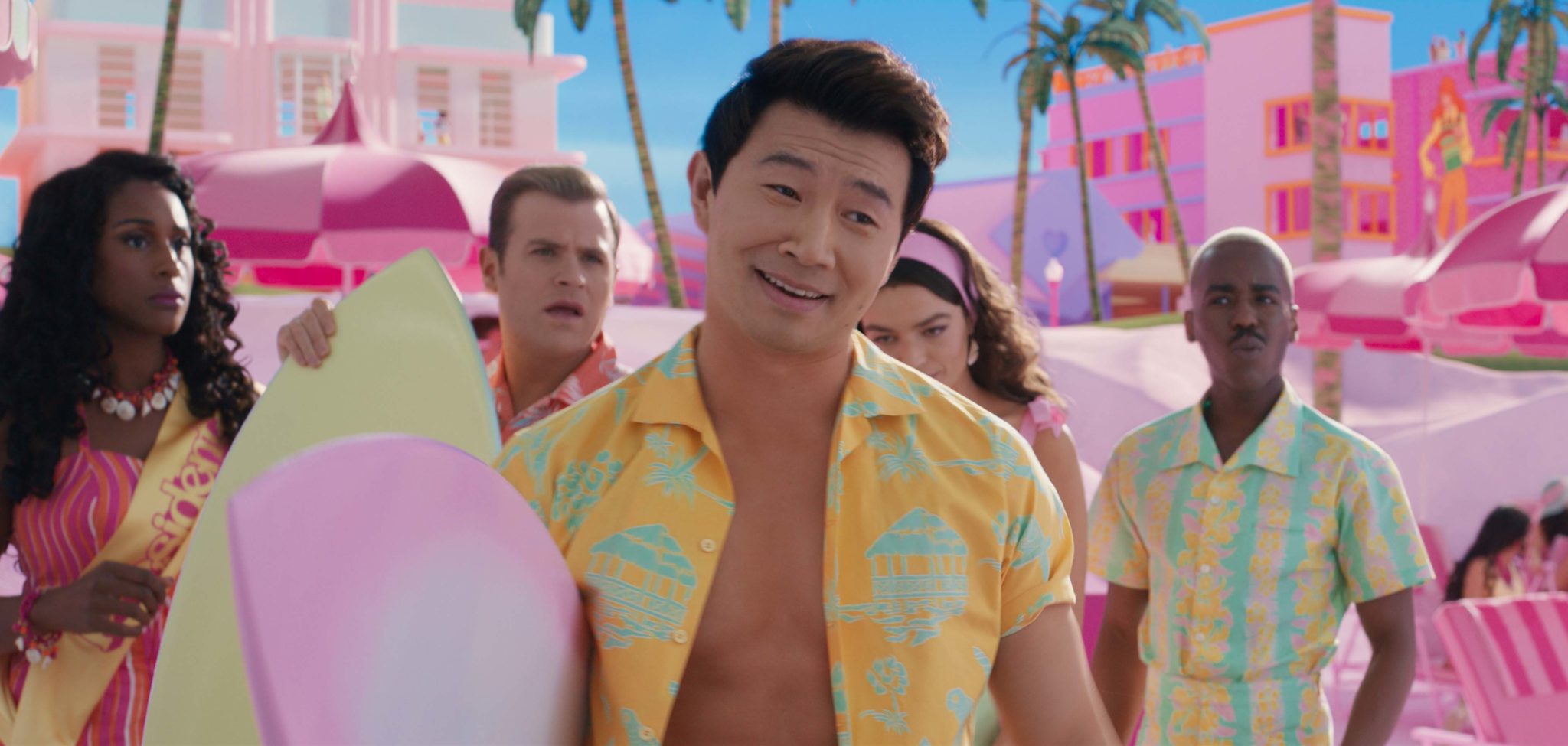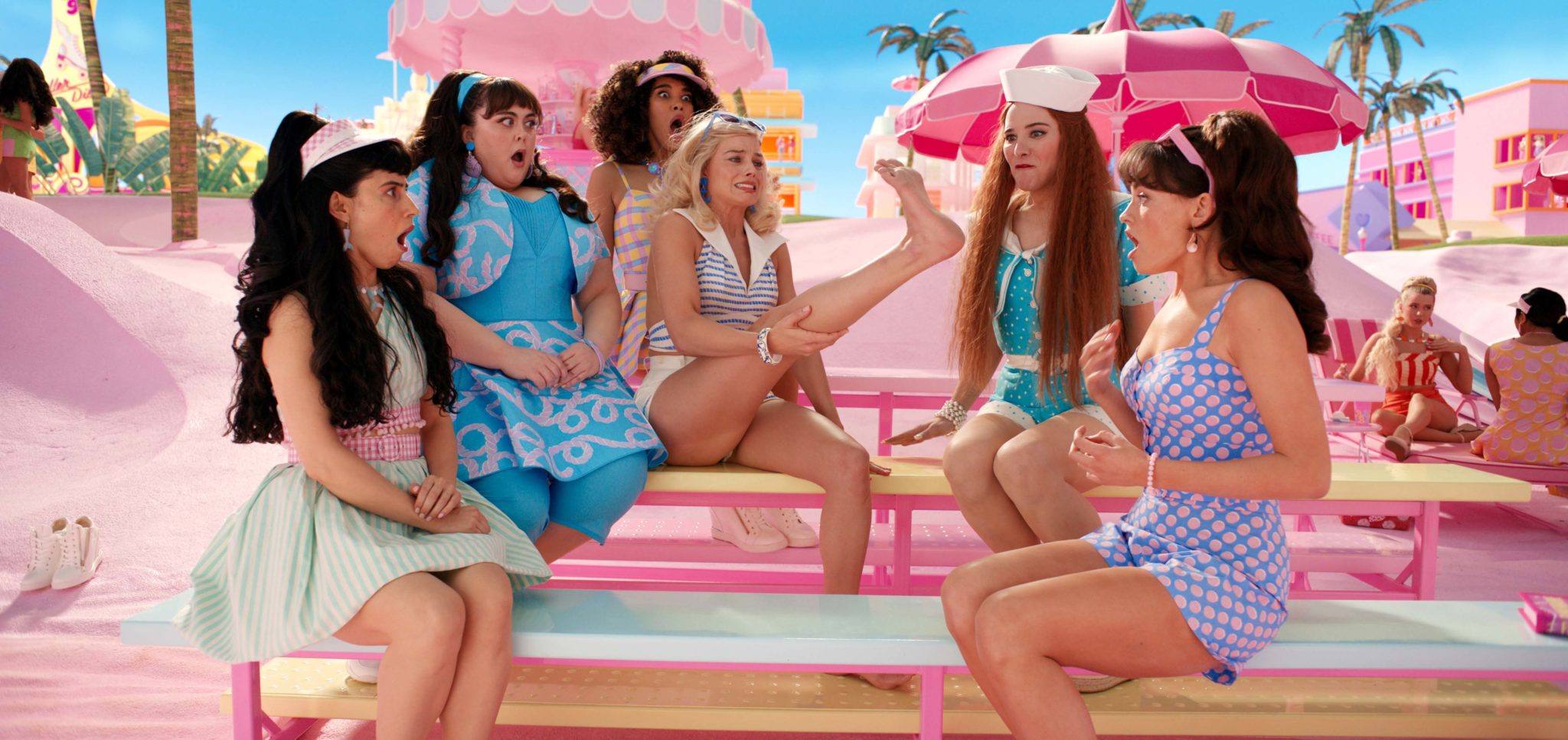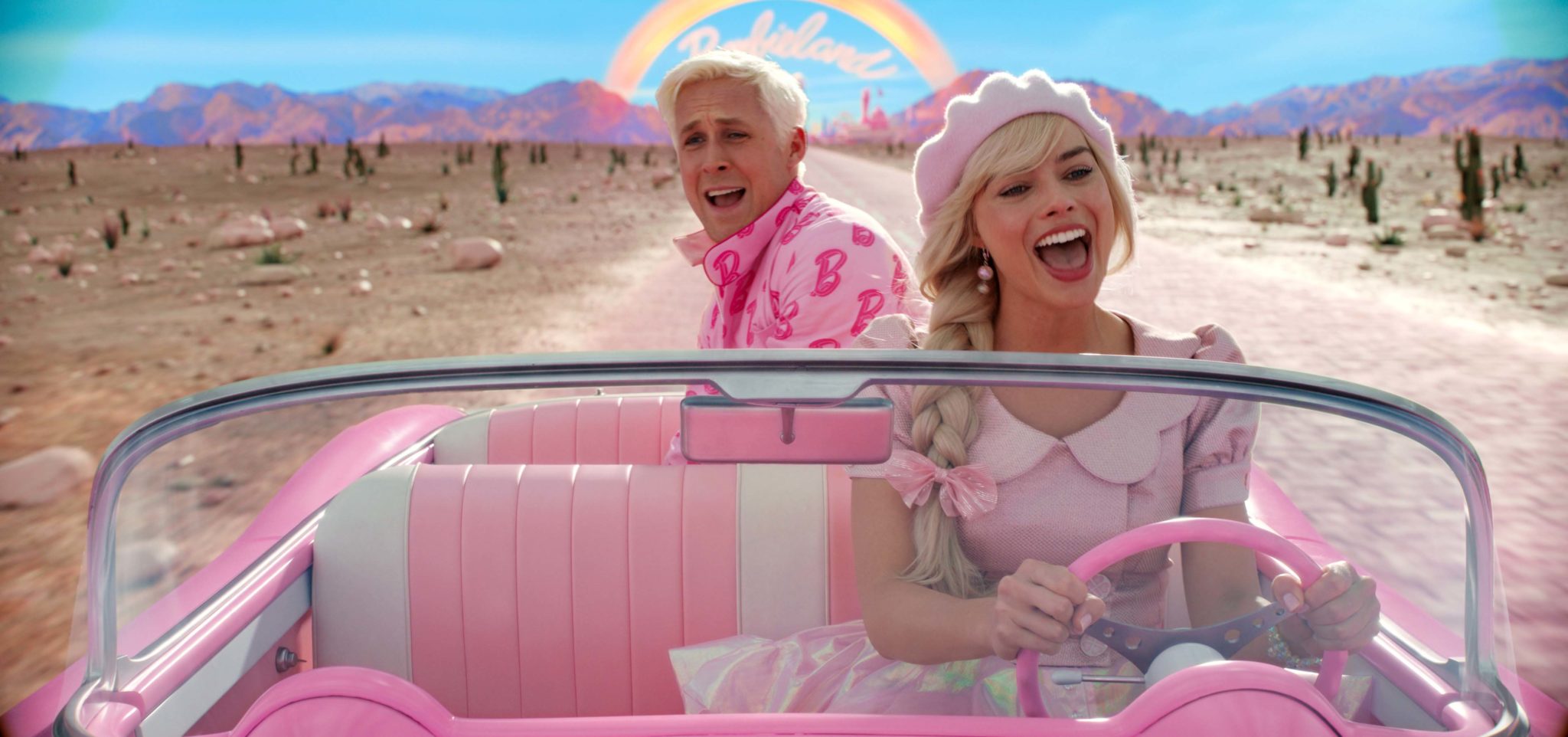- Film And TV
- 20 Jul 23

Barbie is glitter-bombing her way into cinemas this month. Roe McDermott gets Greta Gerwig’s take on the film, and explores the marketing, design, diverse casting and soundtrack set to make it the most fun movie of the year.
One of the biggest weeks in cinematic history is nearly upon us, and there are important questions to consider. On July 21, which film will bisexuals go see first, Oppenheimer or Barbie? Will audiences understand Oppenheimer if they haven’t seen Barbie first? And of course, how much pink can you wear to the cinema without the bubble-gum glow distracting from the screen?
Given Christopher Nolan’s hardcore fanbase and the gravity of the subject matter of his latest film, which explores the development of the first nuclear weapons, it was going to take a serious cinematic contender to challenge him at the box office on opening weekend.
But then, Nolan probably wasn’t banking on having to compete with someone who is not just a chemist and astrophysicist but also a filmmaker herself. Not to mention an interior designer, ice-cream shop worker, vet, dentist, figure skater, NASCAR driver, beekeeper – oh, and a Canadian Mountie – among 200 other vocations. You just can’t keep a woman in STEM down.
 Barbie. Credit: Warner Bros.
Barbie. Credit: Warner Bros.Advertisement
Indeed, sometimes it’s been hard to tell the trailers for the two films apart. Quick, pop quiz: was it Barbie or Oppenheimer who said, amidst an existential crisis, “You guys ever think about dying?”
The hype for Greta Gerwig’s Barbie movie has been irrepressible, thanks in no small part to the film’s ingenious marketing strategies. As well as the hilarious trailers that show how Gerwig has captured Barbie’s pink plastic world to perfection, you can see inside the Barbie Dreamhouse on a stylish video by Architectural Digest. If looking isn’t enough, and you want to actually stay in Barbie’s oceanside mansion in Malibu, there’s now a life-size pink building that you can actually win a real night in.
Photos of stars Margot Robbie and Ryan Gosling rollerblading in neon outfits and requisite visors on Venice beach went viral last year, starting a new Y2K neon trend (and a rush on the neon rollerblades themselves, $289 on Impala Skate). Star Margot Robbie has spent the press tour in sublime outfits paying homage to Barbie’s greatest fashion moments, including a black and white Hervé Leger bodycon dress that evoked Barbie’s very first striped swimsuit in 1959 (and even Robbie’s cursed Chanel contract has been well-used, as the iconic pink tweed just screams ‘Businesswoman Barbie’, or maybe ‘Avon Representative Barbie’, another one of her illustrious careers).
Gosling, usually thoughtful and considered about his movies, has leaned into the delightful camp and silliness of his role as peroxide blonde dreamboat Ken, declaring in one interview, “Ken, his job is beach. For 60 years, his job has been beach. What the fuck does that even mean?”
ORIGINAL GIRL EMPOWERMENT
The film is directed by Greta Gerwig (Frances Ha, Little Women, Lady Bird) from a script co-written by Oscar nominee Noah Baumbach (The Squid and the Whale, Marriage Story) – both indie darlings, and possibly not the immediate team one would envisage for the plastic pink project. But then, the idea for a Barbie movie has been floating around for years, waiting for the right creative team.
Back in 2016, Sony Pictures had the rights to “Barbie” and cast Amy Schumer to star in a movie based on an original idea and screenplay by Hilary Winston. Schumer and her sister, Kim Caramele, planned rewrites, but the comedian left the project less than a year later, citing scheduling difficulties, though she later revealed to Andy Cohen on Watch What Happens Live that, “It really was just creative differences. But you know, there’s a new team behind it, and it looks like it’s very feminist and cool, so I will be seeing the movie.” Schumer also said that Sony “definitely didn’t want to do it the way I wanted to do it, the only way I was interested in doing it.”
Advertisement
 Barbie. Credit: Warner Bros.
Barbie. Credit: Warner Bros.Years later, Robbie – who also runs her own female-focused production company, LuckyChap entertainment which has produced I, Tonya, Birds of Prey and Promising Young Woman – got the rights, and handpicked Gerwig to direct.
“Barbie came to me through Margot Robbie,” says Gerwig, “Margot was the one who had gotten the rights, had brought it to Warner Bros., had sort of spearheaded this whole project, and we had met, and I was a big fan of hers as an actress. But then when we talked, I realised what an incredible producer she was. She was super smart and extremely involved and really interesting.”
And, of course, the ideal Barbie.
“Margot is our Stereotypical Barbie,” continues Gerwig. “As she says in the film, ‘I’m the Barbie everyone thinks of when you think of Barbie’. And when you think of the most beautiful, cheerful, friendly, blonde lady you’ve ever seen, that’s Margot! But the thing I wanted to do most of all was allow her to be outrageously funny.
“She’s the person you’re going to go on a real journey with in the movie, and because she’s always able to make things grounded, relatable and very emotional, even when it’s ridiculously heightened and funny, you never feel like you lose the humanity.”
Advertisement
Gerwig was excited by the prospect of taking such a beloved character and bringing her not only to life, but into the modern era. Barbie has always been both a beloved and a debated figure. The doll has been accused of promoting unattainable beauty standards for young girls. But over time, there have been Black Barbies, plus-sized Barbies, and Barbies in wheelchairs. She’s also come to represent female ambition, with Barbie’s 200-plus jobs letting little girls imagine themselves as accomplished achievers.
As toy manufacturer and Barbie creators Mattel say, “Starting at age 5, many girls begin to develop limiting self-beliefs. They stop believing their gender can do or be anything. This is the Dream Gap, and this is the year Barbie begins working to close it. As the original girl empowerment brand, we’re proud to announce the Dream Gap Project, an ongoing global initiative that aims to give girls the resources and support they need to continue to believe that they can be anything.”
 Barbie. Credit: Warner Bros.
Barbie. Credit: Warner Bros.DIVERSE REPRERSENTATION
Of course, most PR can be taken with a quiet grain of salt (a full meal for a Barbie!). But the discourse around Barbie points to how iconic and influential she is – and it’s this perfection-driven, icon status that made Gerwig feel there was something interesting to explore. What would happen if Barbie’s world of perfection began to crumble, and how she would fare in the real world?
“Barbie has so much recognition, so much love, and of course a 60-plus-year history, which was exciting for me,” says Gerwig. “As a writer and a director, I’m always looking for a fun challenge. As with Little Women, Barbie is a property we all know. But to me she felt like a character with a story to tell, one that I could find a new, unexpected way into, honouring her legacy while making her world feel fresh and alive and modern.”
Advertisement
She was determined to make the world of Barbie feel diverse, and as well as Robbie, other Barbies onscreen include Kate McKinnon, Issa Rae, Hari Nef, Alexandra Shipp and Ana Cruz Kayne.
“The idea of the multiplicity of the Barbies and then the Kens really did come out of my first meeting with Mattel,” says Gerwig. “When I started talking about different characters they said, ‘No, we don’t have different characters. All of these women are Barbie’. And I replied that if all of these women are Barbie, then Barbie is all of these women, and they said, ‘Yes’.”
Actress Alexandra Shipp, known for playing singer Aaliyah in Aaliyah: The Princess Of R&B and Kimberley Woodruff in Straight Outta Compton, says that seeing a diverse cast of women all play Barbie felt like Gerwig was really trying to live up to the promise and potential of the character.
“It was beautiful to see the various types of Barbies that Greta brought in – people from all ethnic backgrounds, of all sizes, some differently abled,” says Shipp. “I think that it’s important for people to see that Barbies don’t just look like Margot, and that means a lot. Greta’s approach to what makes each Barbie unique was a mixture of getting to know us as individual humans, and then fusing that with what she saw for these various Barbies.”
 Barbie. Credit: Warner Bros.
Barbie. Credit: Warner Bros.Ana Cruz Kayne, who had a small role in Gerwig’s Little Women, also found the diverse representation refreshing.
Advertisement
“I have a very diverse background as my mom is from the Philippines and my father is a Jewish man, so I was raised deeply in both cultures,” says Kayne. “And I don’t think that is a unique story to me. I think there are many people who hold two cultures very richly in their lives and they don’t present one physically and phenotypically, but it is actually extremely unique to them and a big part of their background. My Barbie represents those people, and I feel emotional about it, because I rarely get to be all the parts of myself.”
Every detail of the film has been meticulously planned, from Barbie’s delightfully artificial world (Gerwig called director Peter Weir to ask about his work on The Truman Show in relation to creating that authentically artificial feel that she wanted for Barbie Land), to the costumes that develop over the film. These illustrate Barbie’s evolution through decades of trends, while the bop-filled soundtrack features Nicki Minaj, Lizzo, Ice Spice, Karol G, HAIM, and Charli XCX among others.
Dua Lipa’s song ‘Dance The Night’ has a sparkly Barbie-themed video with Gerwig, Robbie and Issa Rae making cameo appearances. Gosling doesn’t appear in the video, but he will be singing ‘I’m Just Ken’ on the soundtrack – a song to rival his work on La La Land, we presume.
“There’s a lot of music in the movie – that was always super important to me,” says Gerwig. “Barbie has a level of optimism that influenced us when we were writing the script, a sort of sincerity mixed with joyfulness meets a ‘doesn’t everybody just want to dance?’ attitude. Mark Ronson really threaded that through the movie with the amazing artists who contribute songs! It was such a treat to work with these artists. And Mark and his partner, Andrew Wyatt, wrote an anthem of sorts for Ken, which Ryan sings. It’s epic. It made me cry when I heard it.”
We could not be more ready. This July, we wear pink.
• Barbie is released on July 21.
Advertisement
The new issue of Hot Press is out now.










